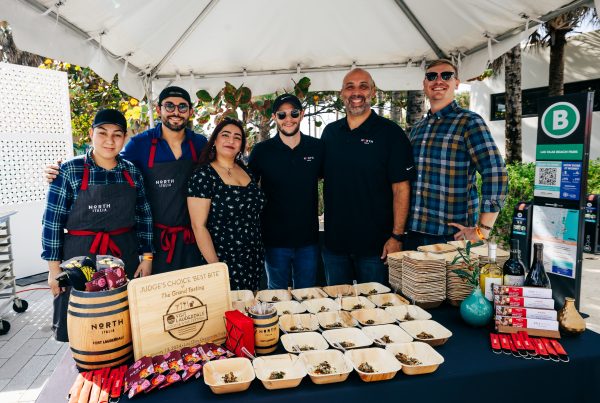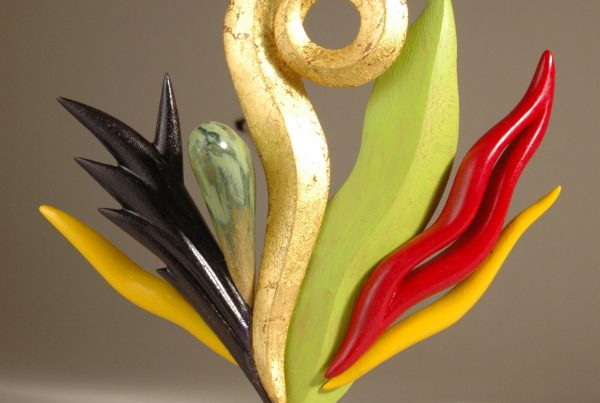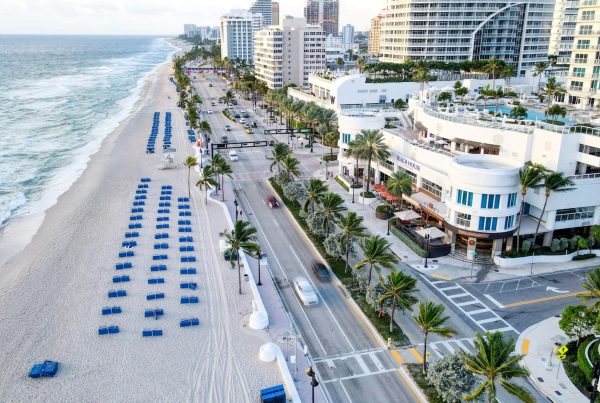Only about a dozen works from the influential and experimental artist Robert Rauschenberg constitute the Norton Museum of Art’s mini retrospective. While it may not share the epic sprawl of its recently closed exhibition of Georgia O’Keeffe paintings, clothing and ephemera, it’s not meant to. Subtitled “Five Decades From the Whitney’s Collection,” it’s comprised of representative highlights from each decade of the artist’s prolific and peripatetic career, exploring how his various milieus, with their own cultural and political baggage, influenced his work. It may be built of tapas, but the exhibition satisfies like an entrée—and with Rauschenberg appearing so infrequently on South Florida museum walls, any showcase of his work is work is cause for celebration.
The earliest work in the exhibition, one of his untitled Black paintings of 1951, burbles with mystery and intensity, critiquing the stylish, vacant flatness of Abstract Expressionism by layering his four-panel canvas with paper bags. Already experimenting with three-dimensional forms, Rauschenberg’s formative monochromatic work would give rise to his famous “Combines,” a decade later, represented here by the iconic “Blue Eagle”—a mad scientist’s hybrid of mixed-media painting and sculpture that fashions a totem out of a T-shirt, tin can, oil can and light bulb.

As difficult as the work is to classify, it’s equally as challenging to explain why it’s so powerful. Like most of his masterpieces, it defies the “meaning” we often seek from great art. The Whitney Museum’s Carrie Springer, who curated the exhibition, cautioned against drawing a “unified story” from the work, noting at its press preview last week that Rauschenberg sought “not to create a narrative but to keep the viewer engaged, and bring his or her own associations to the work. We’re meant to be participants.”
Rauschenberg’s engagement with society’s discarded materials continued into the 1970s with his unusually stirring “Glass/Channel/Via Panama,” a wall assemblage of flattened and 3D cardboard boxes culminating in a site-specific punctuation mark: a rope leading down into a cardboard box on the gallery floor. Tracking the piece’s elegant formal qualities from left to right is like following an obscurist map that ends in oblivion, and it’s easy to see a mathematical mind at work.
The late ‘70s and early ‘80s show perhaps Rauschenberg’s most dramatic leap from minimalism to maximalism. We bathe in the relative serenity and simplicity of 1976’s “Que (Jammer),” an unadorned sprawl of blue and white fabric, derived from a recent visit to the textile factories of Ahmadabad, India. Yet two years later, and hanging on the opposite wall at the Norton, Rauschenberg completed “Hog Heaven,” a beguiling combination of photo collage—on wood panel and fabric—and unorthodox site-specific sculpture, with the medium a giant tire. The found imagery is full of witty juxtapositions—opulent architecture and football players; Karl Marx sandwiched, literally, between a couple of hamburgers—that speak to Springer’s comment about deriving our own meanings from the work.

“Primary Mobiloid Glut,” from 1988, is an impactful example of Rauschenberg’s almost Dadaist approach to sculpture, conceiving a kind of wilted, shape-shifting bicycle out a wheel, gears, piping, a small ladder and other found materials. The artist had just encountered an environmentally damaging oil boom in Houston, and Springer sees the sculpture as “a sorrowful commentary on the economy and people. It’s no longer the sleek vehicle it once was.” I see the piece for its anthropomorphic qualities: It looks like a dying animal.
You may see something else, and that’s what makes Rauschenberg’s work still so relevant, and why so many contemporary artists continue to create in his shadow, whether conscious of it or not. “Five Decades From the Whitney’s Collection” is a concise introduction to Rauschenberg’s enormous oeuvre, whetting our appetite for more.
“Robert Rauschenberg: Five Decades From the Whitney’s Collection” runs through June 28 at Norton Museum of Art, 1450 S. Dixie Highway, West Palm Beach. Admission is $15-$18 Sun.-Thurs., and free Fridays and Saturdays. Call 561/832-5196, or visit norton.org.







